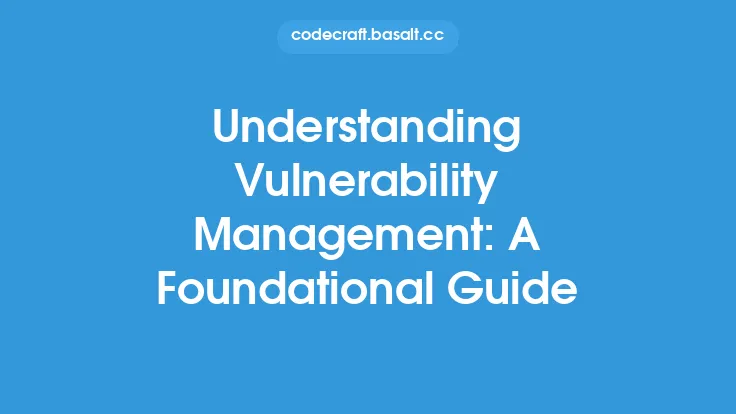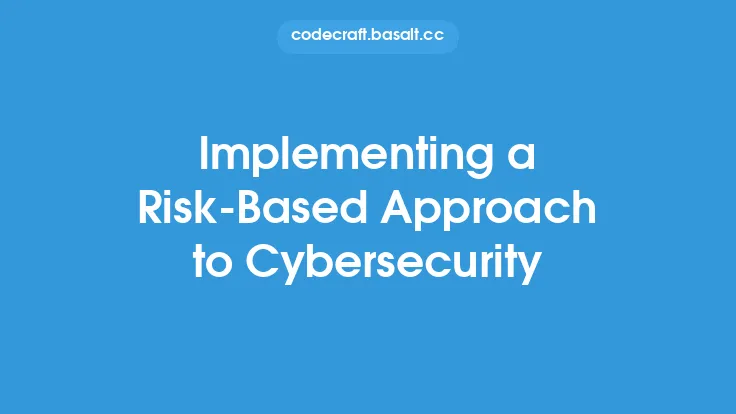In the realm of cybersecurity, managing vulnerabilities is a critical aspect of protecting an organization's assets from potential threats. Vulnerability management involves identifying, classifying, prioritizing, and remediating vulnerabilities in systems, networks, and applications. However, vulnerability management is often siloed from other IT processes, such as change management, which can lead to inefficiencies and increased risk. Integrating vulnerability management with change management can provide a holistic approach to security, enabling organizations to proactively manage vulnerabilities and minimize the risk of security breaches.
Introduction to Change Management
Change management is a systematic approach to managing changes in an IT environment, ensuring that changes are properly assessed, approved, implemented, and documented. The goal of change management is to minimize the risk of disruptions to IT services and ensure that changes are aligned with business objectives. Change management involves a series of processes, including change request submission, assessment, approval, implementation, and review. By integrating vulnerability management with change management, organizations can ensure that vulnerability remediation is properly assessed, approved, and implemented, reducing the risk of security breaches.
Benefits of Integrating Vulnerability Management with Change Management
Integrating vulnerability management with change management provides several benefits, including improved risk management, increased efficiency, and enhanced compliance. By incorporating vulnerability management into the change management process, organizations can ensure that vulnerability remediation is properly prioritized and implemented, reducing the risk of security breaches. Additionally, integrating vulnerability management with change management can help organizations to streamline their IT processes, reducing the time and effort required to remediate vulnerabilities. Furthermore, integrating vulnerability management with change management can help organizations to demonstrate compliance with regulatory requirements and industry standards, such as PCI DSS and HIPAA.
Technical Considerations for Integration
Integrating vulnerability management with change management requires careful consideration of technical factors, including vulnerability scanning, prioritization, and remediation. Vulnerability scanning involves using automated tools to identify vulnerabilities in systems, networks, and applications. Prioritization involves assessing the risk associated with each vulnerability and prioritizing remediation efforts accordingly. Remediation involves implementing fixes or patches to mitigate vulnerabilities. To integrate vulnerability management with change management, organizations must ensure that their vulnerability scanning tools are integrated with their change management systems, enabling them to automatically generate change requests for vulnerability remediation. Additionally, organizations must ensure that their prioritization and remediation processes are aligned with their change management processes, enabling them to properly assess and approve changes.
Process Considerations for Integration
Integrating vulnerability management with change management also requires careful consideration of process factors, including change request submission, assessment, approval, implementation, and review. To integrate vulnerability management with change management, organizations must establish a process for submitting change requests for vulnerability remediation, assessing the risk associated with each change, approving changes, implementing changes, and reviewing the effectiveness of changes. Additionally, organizations must ensure that their vulnerability management processes are aligned with their change management processes, enabling them to properly prioritize and implement vulnerability remediation. By establishing a clear and consistent process for integrating vulnerability management with change management, organizations can ensure that vulnerability remediation is properly managed and that the risk of security breaches is minimized.
Tools and Technologies for Integration
Several tools and technologies are available to support the integration of vulnerability management with change management, including vulnerability scanning tools, change management systems, and integration platforms. Vulnerability scanning tools, such as Nessus and Qualys, can be used to identify vulnerabilities in systems, networks, and applications. Change management systems, such as ServiceNow and BMC Remedy, can be used to manage change requests and implement changes. Integration platforms, such as API-based integration tools, can be used to integrate vulnerability scanning tools with change management systems, enabling organizations to automatically generate change requests for vulnerability remediation. By leveraging these tools and technologies, organizations can streamline their vulnerability management and change management processes, reducing the time and effort required to remediate vulnerabilities.
Best Practices for Integration
To ensure successful integration of vulnerability management with change management, organizations should follow several best practices, including establishing clear policies and procedures, providing training and awareness, and continuously monitoring and reviewing the integration. Establishing clear policies and procedures is critical to ensuring that vulnerability management and change management processes are properly aligned and that changes are properly assessed, approved, and implemented. Providing training and awareness is also critical to ensuring that IT staff understand the importance of integrating vulnerability management with change management and are equipped to properly manage the integration. Continuously monitoring and reviewing the integration is also critical to ensuring that the integration is effective and that the risk of security breaches is minimized. By following these best practices, organizations can ensure that their integration of vulnerability management with change management is successful and effective.
Conclusion
In conclusion, integrating vulnerability management with change management is a critical aspect of protecting an organization's assets from potential threats. By integrating vulnerability management with change management, organizations can ensure that vulnerability remediation is properly assessed, approved, and implemented, reducing the risk of security breaches. To achieve successful integration, organizations must consider technical, process, and tool-related factors, and follow best practices for integration. By leveraging the benefits of integration, organizations can improve their risk management, increase efficiency, and enhance compliance, ultimately reducing the risk of security breaches and protecting their assets.





